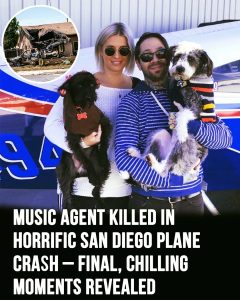In the quiet pre-dawn hours of Thursday morning, the serenity of a San Diego neighborhood was shattered by the deafening roar of a jet crashing into the residential heart of Murphy Canyon, a community largely occupied by military families. The explosion was immediate and devastating, sending flames and debris across homes and streets, and forcing over a hundred residents to flee into the thick, early morning fog. The crash claimed the lives of six individuals, including Dave Shapiro, a 42-year-old powerhouse in the music world and co-founder of Sound Talent Group.

Shapiro was widely respected for his role in launching and nurturing the careers of numerous artists including Sum 41, Vanessa Carlton, and Hanson. But beyond the music scene, he was a passionate aviator, a licensed pilot, and a flight instructor. He had turned his love for flying into a second career, operating Velocity Aviation, a company that offered training in helicopters, aerobatics, and even BASE jumping. His journey with aviation began when he was 22, after he took an introductory flight lesson with his first bit of disposable income. That flight sparked a lifelong passion.
Tragically, it was a journey that ended too soon. Shapiro was flying his 1985 Cessna S550, registered under DAVIATOR LLC, a company based in Alaska, when the plane crashed just two miles from its intended destination. The aircraft had departed from Teterboro Airport in New Jersey on Wednesday night, stopped to refuel in Wichita, and was headed for San Diego. On its final descent, shrouded in dense fog, the jet struck power lines and crashed into a row of homes, igniting cars and causing extensive structural damage. One vehicle burned for hours. Jet fuel spilled into the gutters, the air thick with the pungent scent of aviation fuel.
Authorities believe the poor visibility played a significant role in the tragedy. According to aviation attorney Barry Newman, FAA protocol requires a pilot to abort the landing if visibility drops below a certain threshold. Audio from liveATC.net revealed the pilot’s final transmission, indicating he was three miles from the runway and on final approach. He never had the chance to call for a missed approach. Debris was found scattered across nearly a quarter mile, with one wing discovered on a nearby street and jet fuel saturating the crash zone.
Among the victims was also Daniel Williams, the former drummer for the metalcore band The Devil Wears Prada. The band, devastated by the loss, posted a heartfelt tribute online: “No words. We owe you everything. Love you forever.”
The crash left an immediate mark on the community. Hancock Elementary School was transformed into an emergency evacuation center. Families, still in their pajamas, huddled together unsure if they had a home to return to. Retired Navy sailor Christopher Moore recounted how he grabbed his three sons and ran past a flaming car, the only thought in his mind being to reach safety. “It was definitely horrifying for sure,” he said. “But sometimes you’ve just got to drop your head and get to safety.”
San Diego Councilmember Raul Campillo praised the bravery of residents, many of whom were active-duty military or veterans. He shared stories of neighbors pulling each other from danger, jumping through windows, and rushing to help as the fire closed in. “I’ve heard dramatic stories about military families helping military families out of their homes, jumping out of windows and avoiding fire,” he stated.
Shapiro’s loss is deeply felt in both the music and aviation worlds. Through Sound Talent Group, he helped shape modern rock and pop, giving artists the platform to thrive. With Velocity Aviation, he encouraged others to pursue flight, always pushing himself and others to keep learning, keep exploring. His Instagram post from May 2020 showed a photo of his FAA credentials, proudly celebrating his check ride in a Citation 525 series jet. “Although I have an established career, I always want to keep learning,” he had written.
His adventurous spirit wasn’t just professional—it was personal. He and his wife, Julia Pawlik Shapiro, lived between San Diego and Homer, Alaska, and shared a love for spontaneous, bold adventures. In 2016, they married in true explorer fashion: obtaining a marriage license, boarding a small aircraft, and flying to a remote glacier in Denali National Park where they exchanged vows after landing on skis.
Julia once described their bond in a blog post, writing, “When I met Dave, we became instantly bonded over the unconventional lifestyles we lead and our constant need for adventure.” That spirit defined Shapiro’s life—a man always in motion, driven by curiosity and purpose.
By the time of the crash, Shapiro had flown over a million miles, his reputation spanning continents and industries. His death leaves behind not only a legacy of musical innovation and aerial expertise but also a profound sense of loss among friends, colleagues, and students he mentored along the way.
The Federal Aviation Administration reported that while this crash joins a troubling pattern of aviation accidents, the overall number of such incidents in 2025 has actually been lower than in recent years. Still, for the families left behind, statistics offer little comfort. The heartbreak is real and raw.
The National Transportation Safety Board (NTSB) is now leading the investigation into what went wrong. Authorities have asked anyone with video footage or direct eyewitness accounts to come forward to aid in the inquiry. Meanwhile, Murphy Canyon begins the slow process of healing — mourning the lives lost and grappling with the surreal trauma of waking up to a tragedy that turned the familiar into a scene of devastation.





